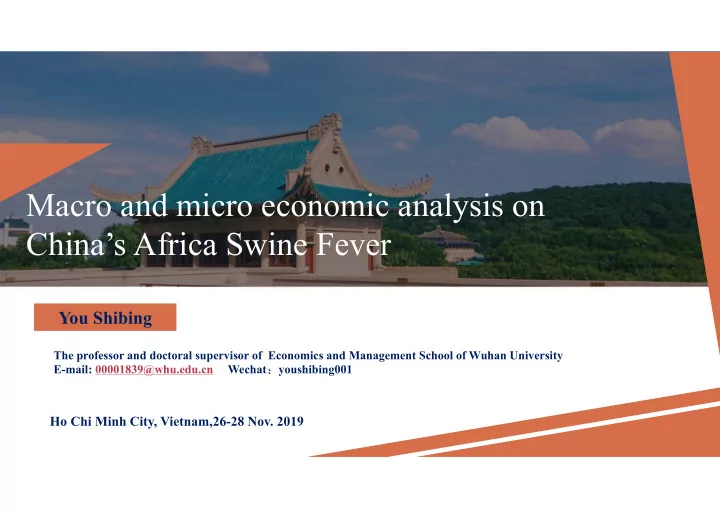

Macro and micro economic analysis on China’s Africa Swine Fever You Shibing The professor and doctoral supervisor of Economics and Management School of Wuhan University E-mail: 00001839@whu.edu.cn Wechat : youshibing001 Ho Chi Minh City, Vietnam,26-28 Nov. 2019 Ho Chi Minh City, Vietnam,26-28 Nov. 2019
CONTENT Qualitative analysis of 1 African Swine Fever Quantitative analysis of African 2 Swine Fever Judgement and prediction 3 Countermeasures and suggestions 4
01 Qualitative analysis of African Swine Fever
Qualitative analysis of African Swine Fever 1.1 Macroscopic Analysis • Macroscopic Analysis in the • Lack of macro management (lack perspective of regional security of publicity, lack of technical • Macroeconomic loss (economic reserves, lack of prevention and loss, spiritual loss, folk-custom control mechanism) loss)
1.Qualitative analysis of African swine fever 1.2 Microscopic Analysis Focuses on Jingzhou city, Hubei province, China Field Research (Small and medium pig farms)
Slaughterhouse owner Farm owner
Field Research (Small and medium slaughterhouses)
Basic information of the field research(Pig farms) annual pig slaughter(milion) Where's the pig?(milion) large farm Sold out 3.8m small and medium Local consume 3m sized farm 2m 1.8m 1m 1.8m 0 0.2m After ASF Before ASF Before ASF After ASF
Basic information of the field research A. Pig farms Before ASF, the annual pig slaughter was about 4.8 million (3 million for large farms, 1.8 million for small and medium-sized farms), among which about 1 million was consumed locally, and the other 3.8 million would be sold elsewhere. After ASF, small and medium-sized farms were almost wiped out (loss 1.8 million) and large farms (loss 1 million and most of which is in cooperation with individual farmers) .
Basic information of the field research(Slaughterhouses) Daily slaughter volume B. Slaughterhouses 320 After ASF, the daily slaughter volume decreased by 3/4 while the operating -75% cost remained almost unchanged. 80 After ASF Before ASF
02 Quantitative Analysis of African Swine Fever Economic Evaluation method of Animal epidemic loss---- “Standard Unit Epidemic Disease”
Standard Unit Epidemic Disease(SUED) The "standard unit epidemic disease" method is a method to evaluate the economic loss of Animal epidemic disease.
How does it work? 1 3 4 2 Take the loss of standard Selects a certain Evaluates the epidemic Achieve the purpose area as a bench mark to representative loss in standard area by of rapid assessment estimate the other epidemic area as setting corresponding of epidemic losses in epizootic region’s loss the standard region evaluation index system other epidemic areas. using entropy method
L L v n v n = = ⋅ ⋅ d d d d Standard area loss assessment Government losses L G= Corresponding government Farm loss: funds Consumer loss: Loss of industrial chain : Economic loss
L L v n v n = = ⋅ ⋅ d d d d Total loss: Standard area loss assessment Environment loss Social loss Loss of public health : Environment loss: Cost of traffic blockade :
Other epizootic region’s loss Epizootic region B’s loss Raw data matrix: Add adjustment coefficient 3 1 2 4 5 Entropy weight dj Normalization processing
Characteristics of SUED It can provide reference for the formulation of emergency strategy. 1 It is easier to draw up historical 2 references It has strong maneuverability, 3 rapidity and timeliness 4 It is a "static" evaluation method.
03 Judgement and prediction
Judgement and prediction 15 months Supply China's pig supply can still meet basic demand, We estimate that it will take about 15 months but the price of pork will continue to rise. for China's pig supply to return to stability.
04 Countermeasures and suggestions
Countermeasures and suggestions: 1.Strengthen publicity and intervention to consumers 2.It is urgent to find the method of collecting epidemic data 3.Study on the speculative behavior of manufacturers in response to Pork offline Industry chain 4.It is suggested that the Government should focus on the cultivation of large-scale farms 5.Formulation of differential epidemic Prevention and Control Strategy according to different time nodes
THANKS
Recommend
More recommend